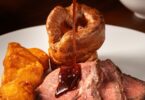What are the best cheeses for melting, and how do I know how they will behave under heat?
Andrew, Gamboa, Panama
We probably first need to define what we mean by melting, says Rob Lightbody from Neal’s Yard Dairy. “Most cheese will melt, but when a cheesemonger talks about ‘a good melter’, they’re probably talking about that satisfying stretch and pull you get from a good toastie, or from raclette melted over potatoes.” But Andrew’s right: because different cheeses do different things under heat, and that comes down to a few factors.
First, says Jazz Reeves, quality manager at cheesemonger Paxton & Whitfield, there’s the moisture and fat content. “When cheese is heated, the protein structure breaks down and it releases the fat and water, so cheese with higher fat and moisture tends to melt well.” Acidity also comes into play: “Cheese with high acidity [eg feta] won’t melt, but low-acidity cheeses [parmesan, say] won’t melt, either, so look for something in the middle.” That’s to say a pH level between 5 and 5.4, says Oli Smith, co-owner of The Bristol Cheesemonger. Mozzarella, he adds, “melts beautifully and produces those extraordinary stretches because it’s at that pH sweet spot of about 5.2”. Then there’s the age of the cheese to consider. “Younger ones are held together by a sort of protein matrix,” Smith explains, but that breaks down with time, which is why you can get those oil pools when extra-mature cheddar goes under the grill.
Steve Cooper, founder of Pistachio & Pickle in London, says his top tip “would be to grate the cheese before adding it to a dish”, because that ensures a speedy, even melt. But don’t rush things: “If you let cheese come to room temperature and take a slow and steady approach to melting,” Smith adds, “it’s less likely to split.”
But what does this all mean in practice? A good place to start, Lightbody suggests, are “those slightly forgotten territorial or place-name cheeses from around the UK”, such as cheshire. Designed to be eaten relatively young, they have higher acidity and moisture, which as we now know result in a nice melt. A cheshire or lancashire, for example, will work well, “plus you get layers of flavour that will add depth to a dish”. As we head into barbecue season, Smith gets an even melt on his burgers by using raclette, Ogleshield or scamorza, while Lightbody favours lincolnshire poacher or even a blue (although that will soften rather than melt). Essentially, Smith adds, if your cheese has “that pliant texture, there’s a good chance it will hold its basic structure and give an even melt”.
Alpine cheeses (comte, gruyere, schnebelhorn) also melt “really, really well” on burgers and toast, Reeves says, plus they’re a dream in fondues and cheese sauces. For the latter, though, Lightbody goes for “something aged and hard with lower moisture”, such as parmesan: “It will respond well to gentle melting at the end of a process and has a concentrated flavour.”
And, as with all cooking, you should never discount flavour. For example, Smith notes that when cheese is baked in a quiche, you’re less concerned about how it holds its shape and more interested in how it mingles with other ingredients. However, if you’re still in any doubt, talk to your cheesemonger – because, as Reeves says, “They’ve all done many melted cheese experiments!”
Courtesy: theguardian







